Best of India Tours
- Golden Triangle Tour- Best of India & Nepal
- Classical Rajasthan
India Cultural Tours
- Images of North India- Karnataka Heritage
- Rajasthan & Goa Tour
Discover India Tours
- Grand India Tour- North to South India
- Central to South India
Rajasthan Tours
- Classical Rajasthan Tour- Golden Triangle Tour
- Grand Mughal Tour
India Luxury Trains
- Palace on Wheels- The Golden Chariot
- India Deccan Odyssey
- The Indian Maharaja
- Royal Rajasthan on Wheels
Nepal Tours
- Glimpses of Nepal- Buddhist Pilgrimage
- Nepal River Rafting
- Destinations of Nepal
- Nepal General Info
India Wildlife Tours
- North India Wild Life- South India Wildlife
Tibet Tours
- Tibet Monastery Tours- Explore Tibet
- Destinations of Tibet
Spa & Yoga Tours
- Ananda in Himalayas- Yoga & Meditation
Adventure Tours
- Manali Safari Tour- Himalayan Trekking
- Horse Safari
Chitrakoot
Bhubhaneshwar
![]() Chitrakoot
Chitrakoot
![]() Gopalpur on Sea
Gopalpur on Sea
![]() Puri
Puri
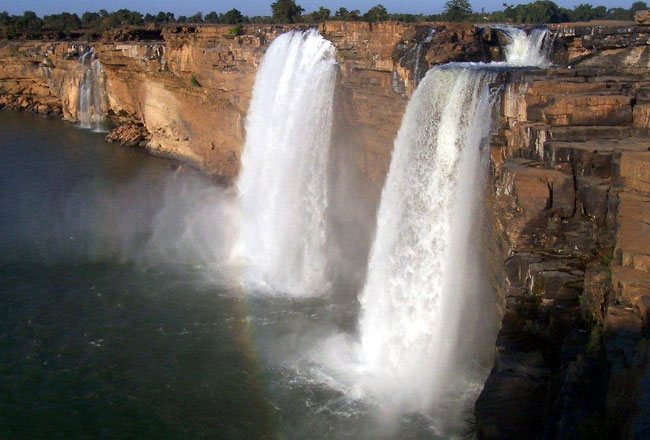
Chitrakoot bears the burden of its heritage lightly, like a great sage unimpressed by his own wisdom. In fact, there/’s a pleasant informality about its affairs. The Mandakini moves with the serenity of a buxom housewife ambling across Chitrakoot. It is also the boundary between two of the largest states of our land: bustling, teeming, Uttar Pradesh and the heart-of-India domain, Madhya Pradesh. The mountain ranges of the Vindhya surround the area. Mixed forests spread in all directions. Despite the ingress of modernity, Chitrakoot and its environs have remained tranquil reminding the visitor of its hallowed past.
Sightseeing
Chitrakoot covers a vast area comprising five villages: Sitapur, Karvi, Nayagaon, Kamta and Khohi. Legend has it that Lord Rama spent many years of his exile in the forests of Chitrakoot. Consequently Chitrakoot is full of shrines, legends and customs associated with the great and revered epic Ramayana. The main pilgrim centre, of course, is Ram Ghat, located on the bank of the river Mandakini. Rising above Ram Ghat are such ancient temples as the Param Kutir, the Bharat Mandir and the Yagya Vedi. The first two are associated with the Ramayana; the third is believed to date back to the very origins of the universe. Most of the spots of tourist importance are along the river Mandakini and the road running parallel to it, except Gupt Godavari (19 km), Deva Ganga and Hanuman Dhara (3 km). The other places of interest are Janaki Kund (2 km), Sphatik Shila (5 km), and Sati Anasuya (16 km).
Excursions
The region around Chitrakoot is also dotted with places of historical and religious importance, besides some excellent picnic spots. A good place to begin your journey is the famous Kalinjara Fort and Neelkanth Temple, located around 50 km south-west of Chitrakoot. The fort stands on the last spur of the Vindhya hills overlooking the Gangetic plains at a height of 275 metres above the plains. Nearby is the Neelkanth Temple which has exquisitely carved panels. Perhaps the most ancient sites in Bundelkhand, these two structures combine the sanctity of hilltops with natural defensive strengths. Maihar is a famous centre of Indian classical music while the Chachai, Keoti, and Bahuti falls are excellent picnic spots on the banks of the river Bihad.
Excursions for Chitrakoot
Ram Ghat
Ram Ghat, the focal point of Chitrakoot, is a long stretch of steps cut into the banks where pilgrims perform religious ablutions and rituals. Many compare its hallowed sanctity to Rishikesh and Benaras. Here, people believe, the sacred river Sarayu surfaces from its subterranean sojourn, and then vanishes again. Here, too, is the Tulsi Chabutra, the platform on the Ram Ghat where the great poet-saint Tulsidas wrote the Ram Charit Manas. Long flights of landing steps lead up from the brown, lapping water. Ferrymen wait expectantly in their canopied barges, often festively decorated with tinsel streamers. Early in the morning, devotees stand waist-deep in the flowing river, worshipping the dawn with an oblation. This is also the time when there is a tintinnabulation of bells ringing from all the shrines at the same time, the hollow calls of conches, and the chants of voices raised in prayer.
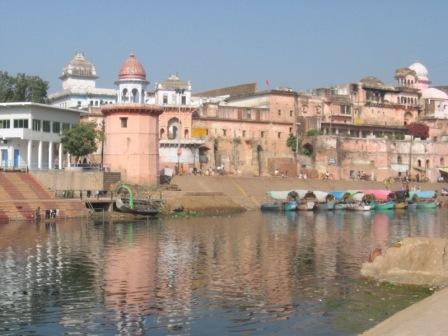
Param Kutir
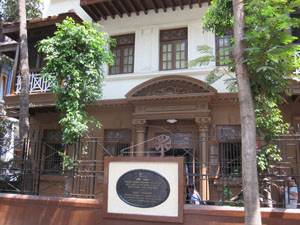
The Param Kutir is believed to be the prime cottage, the first hut, erected by Lakshmana for his brother and sister-in-law. As the eminent scholar C. Rajagopalachari says, /”Lakshmana was a clever workman. He soon constructed a strong hut, which was weatherproof and made it comfortable and convenient. Single-handed, he completed the mud hut with windows and doors, all made of bamboo and jungle material./” Clearly, such a fragile hut could not last the eons that have lapsed since the age of Lord Rama. The Param Kutir has been reconstructed as a temple, popular with worshippers today.
Bharat Mandir
Lord Rama/’s younger bother, Bharat, came to Chitrakoot to persuade the prince to return from exile and assume his rightful position as ruler of Ayodhya. He was unsuccessful but, according to a local legend, Bharat and his army of /”chariots, elephants, horses and foot soldiers/”, as well as the royal family and nobility of Ayodhya, camped a little below Param Kutir. Today, that spot is marked by the Bharat Mandir where the whole court is worshipped as resplendent idols.
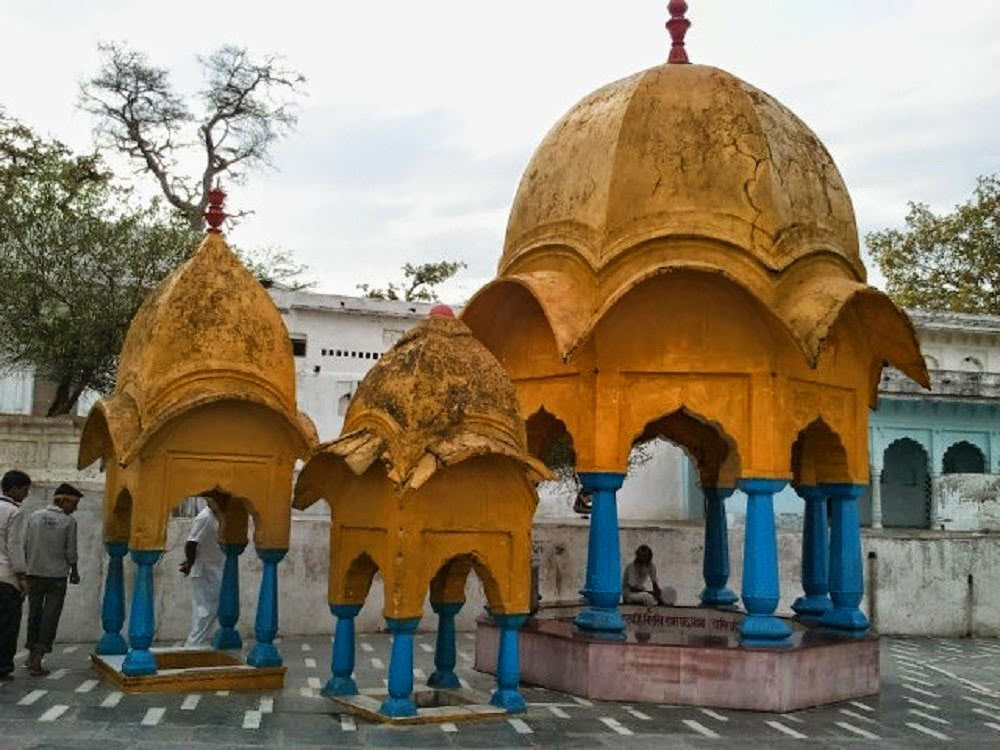
Janaki Kund
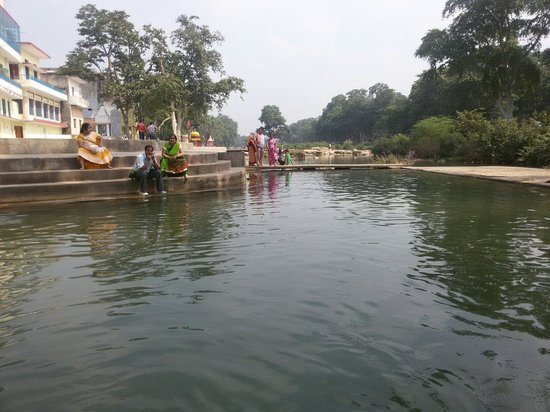
The steep escarpments and thickly wooded embankments upstream of Mandakini give way to the Janaki Kund, considered to be the favourite bathing spot of Sita. A straight stretch of river and a series of steps on the left bank descend down to the water, almost greenish-blue in colour. The sounds of temple bells waft through the stillness if you happen to visit the place early in the morning. The recitation of prayers is broadcast through the loudspeakers and pilgrims start arriving even before the eastern sky turns orange.
Sphatik Shila
Beyond Janaki Kund, the river is enchantingly beautiful, the tilting boughs adding to the beauty. A further journey upstream leads you to Sphatik Shila where a large boulder bears the impressions of Lord Rama/’s footprints. Another thing that is likely to attract your attention are the horde of monkeys swinging on the branches of trees overheads. Pilgrims offer peanuts to the monkeys, as many hold these primates in reverence as the descendants of the monkey-god Hanuman.
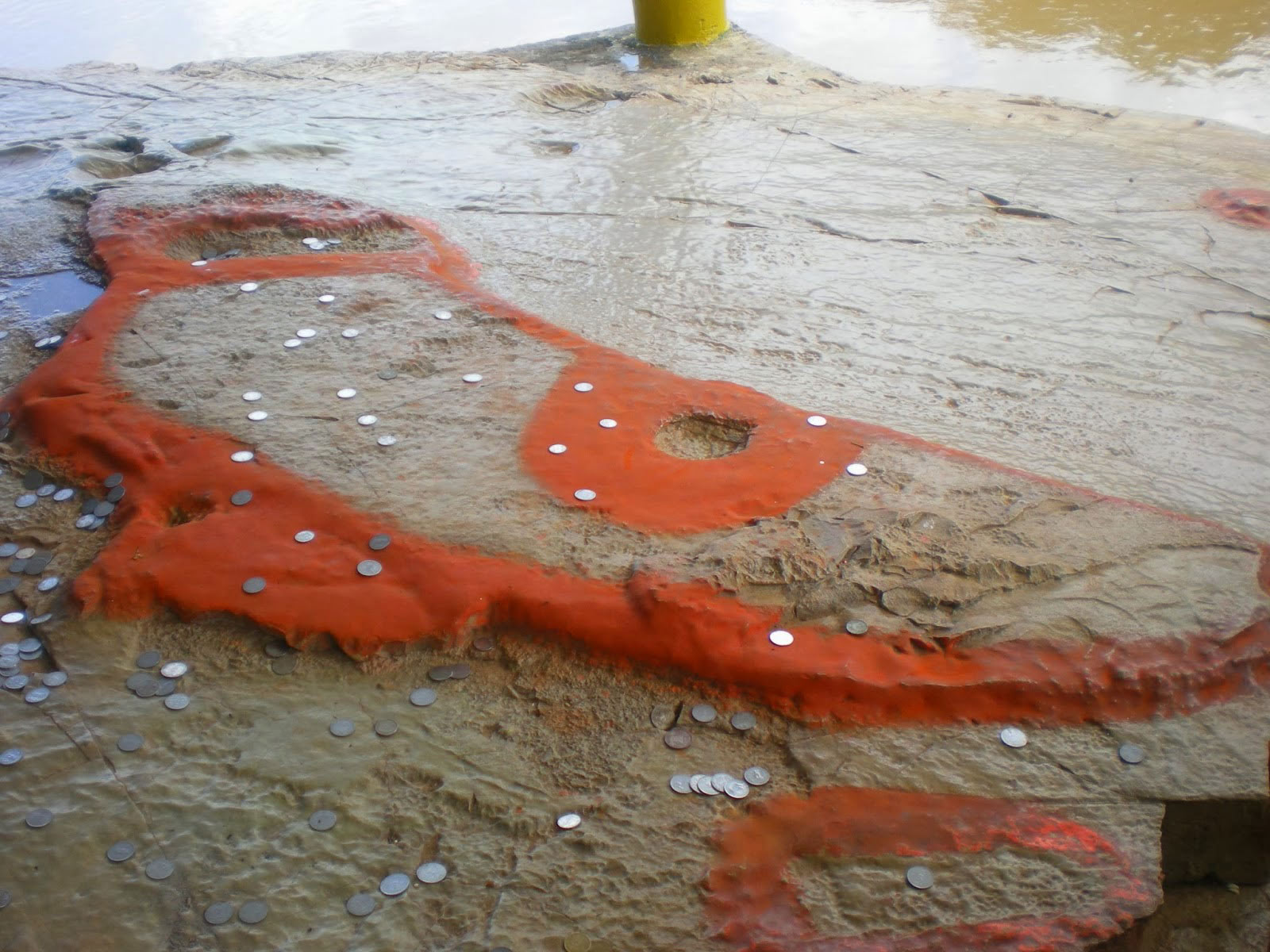
Kamadgiri Mountain
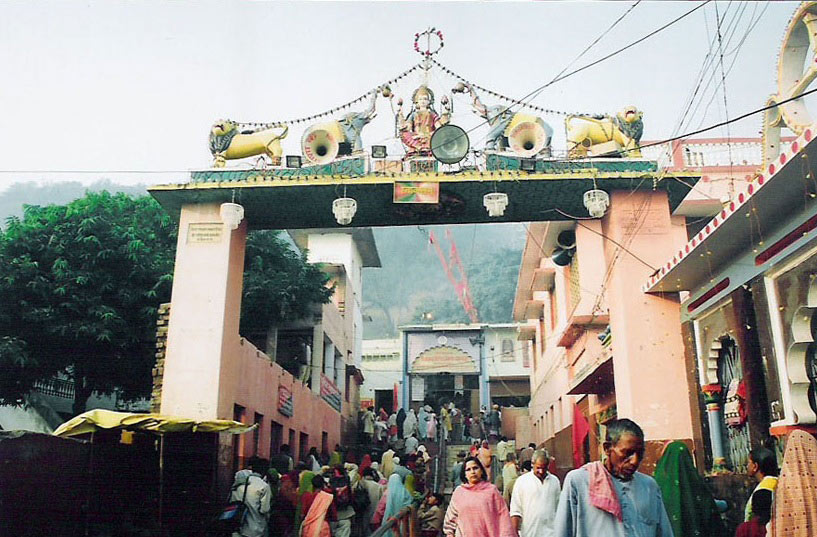
Legend has it that before creating the universe, Lord Brahma performed a powerful ritual with 108 fire pits, which fashioned the landscape of Chitrakoot. However, modern-day geologists would have it that the step-like structures of the Deccan Trap were formed by lava welling up from the depths of the earth. Consequently, mountains in this region hold huge caves. The entire, bow-shaped, mountain of Kamadgiri is believed to be hollow, thereby concealing an enormous lake in its interiors. Around this subterranean reservoir, it is said, sages sit in timeless meditation. Perhaps this is why Rishi Bhardwaj advised Lord Rama to spend much of his exile around this supremely serene place.
Today, devotees walk barefoot around this mountain, convinced that their wishes will be granted by this spot, hallowed by the royal exiles and the sages. The hollow mountain is said to have four doors: the Pramukh Dwar, or main entrance, which is now a shrine, and three other portals. No ordinary human has crossed this mysterious threshold and seen the great lake inside Kamadgiri, but there/’s a curious phenomenon associated with the mountain. Rain falling on the protected trees of this hill does not run off, but sinks in and then emerges as 360 springs that start flowing at the same time as if they were the outlets of an overflowing underground lake.
Gupt Godavari
Nineteen kilometres to the south of Ram Ghat is a great cavern called Gupt Godavari. Deep in this cave, according to legend, the river Godavari emerges as a perennial stream from the rocks, flows down to another cave below, and then disappears. A massive rock protruding out of the ceiling of the Gupt Godavari cave is said to be all that remains of the demon Mayank. He had the temerity to steal Sita/’s clothes while she was bathing and was petrified by the vigilant Lakshmana. Another legend has it that Lord Rama held court in this cave, along with his faithful brother Lakshmana, during their exile. At the entrance to the cave is a beautifully carved sculpture of the Trinity (Brahma, Vishnu and Shiva) .
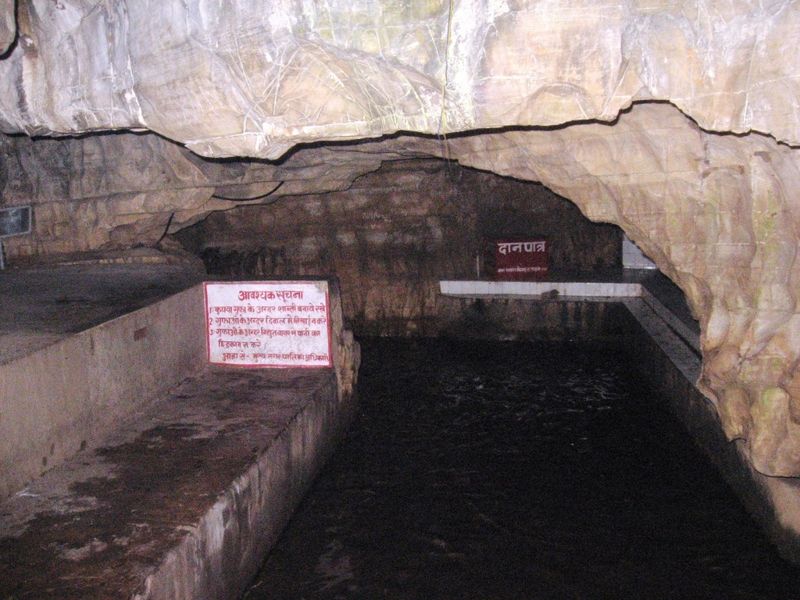
A word of warning. If you are scared of bats, be a little wary when you enter Gupt Godavari. They hang in clusters from the ceiling, twittering, quarrelsome, fluttering, emitting their high-pitched squeaks whose echoes help them avoid obstacles in the dark.
Do look out over the plains of Chitrakoot from this high point. As your eyes travel closer and closer to the sacred lands around the Mandakini river, the terrain becomes appreciably greener and greener, protected by the veneration of the soil of Chitrakoot. Indeed, the burden of its timeless heritage sits very lightly on tolerant Chitrakoot.
Sati Anasuya
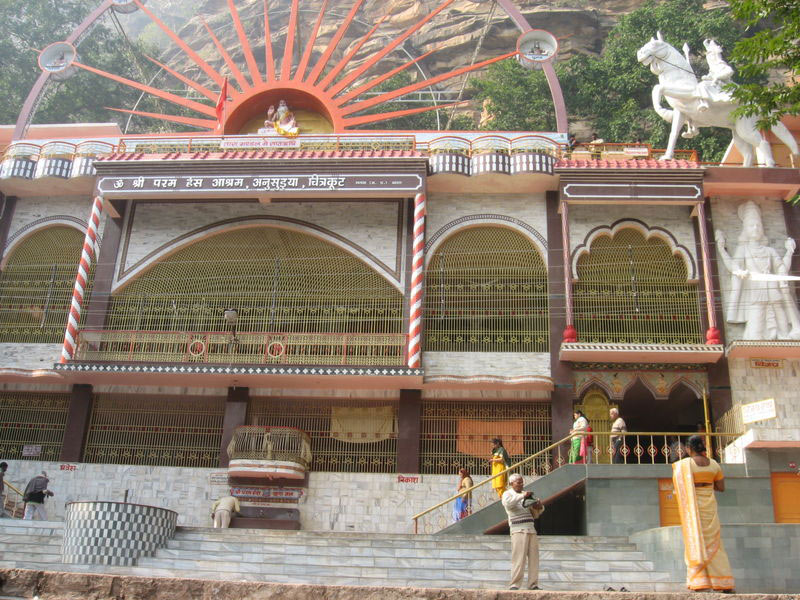
When you emerge from the cool, slightly musty, darkness of the cave into the fresh, bright, loam-scented hills, you will realize that faith has done more for the preservation of the ecology of Chitrakoot than all the laws of man. This green environment recharges the Mandakini which is said to originate in the hills near Rishi Atree/’s ashram. Today a monastery marks the traditional site where Rishi Atree, his wife Anasuya, and their three sons meditated. It is believed that the Mandakini originated as a result of the meditation of Anasuya.
Hanuman Dhara
On one of Chitrakoot/’s wooded hills, 5 km from Ram Ghat, you will come across a shrine dedicated to Hanuman, the great warrior. Aptly christened the Hanuman Dhara, pilgrims trudge a steep 360-step stairway to seek the blessings of Hanuman. Legend has it that Hanuman flew to this hill, enflamed with rage and victory, after setting fire to Ravana/’s palace in Lanka, and helping to rescue Sita. To cool his wrath, he stood under a stream of icy water gushing out of a rock in Hanuman Dhara. His idol still stands bathed by a flow of cold, crystal-clear, water. While you are at Hanuman Dhara take some time off to stop at the old step-well, on the way up: it reputedly never goes dry, thanks to the rain-trapping forests of Chitrakoot.
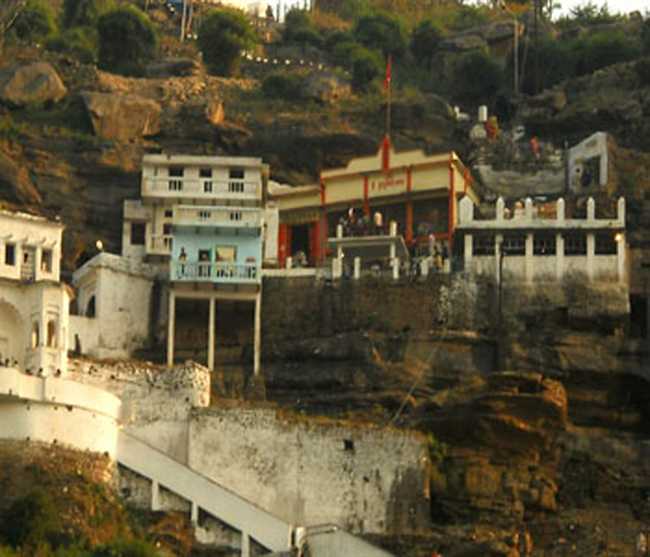
Further findings of black polished inscribed pieces of pottery of Ashokan Brahmi script and a number of inscriptional evidence such as Kushan inscriptions, ornamental Brahmi, etc., have corroborated in establishing Lalitagiri as a flourishing Buddhist centre of the second century BC. The excavations at Ratnagiri, on the other hand, have revealed the remains of an imposing stupa, two quadrangular monasteries, a single-winged monastery, eight temples, a large number of small stupas, sculptures, and architectural pieces indicative of an establishment that can be compared with the major Buddhist sites in the world. The site also yielded a rich crop of antiquities. Particularly noteworthy are the bronze and stone images of the Buddha and a host of idols of the Buddhist pantheon. A large head of the Buddha found on top the hill indicates the colossal nature of the original images.
Govindgarh
Situated 19 km from Rewa, Govindgarh is famous for its scenic beauty and ripe mangoes. The area around Govindgarh was once the natural habitat of the rare white tiger, which, unfortunately, has become extinct by now. (The last white tiger was sighted here in 1951.) The Govindgarh Palace on the banks of a huge lake houses the personal museum of the Maharajah of Rewa.
Kalinjara Fort and Neelkanth Temple
Kalinjara Fort, 50 kilometres south-west of Chitrakoot, is one of the hallowed places that find mention in the Puranas and Mahabharata. /”The gradual acclivity, the abrupt ascent, and stupendous fortifications of Kalinjara, towering 900 feet above the plains, present a scene grand, majestic and sublime,/” wrote Captain William Pagson, of the Bengal Army, in 1835. Perhaps the physical immensity of the Fort has remained unchanged. It was in the reign of the Chandela dynasty in the 10th and 11th centuries that the fort finds increasing mention and importance. In the early 10th century, the Chandela King, Yasovarman, on ascending the throne, was given the title of /’Kalinjaradipati/’, or Lord of Kalinjara. The steep trek that leads to the fort gives credence to the theory that no enemy ever stormed this Chandela bastion, and hence it had to captured only through treachery or a long siege.
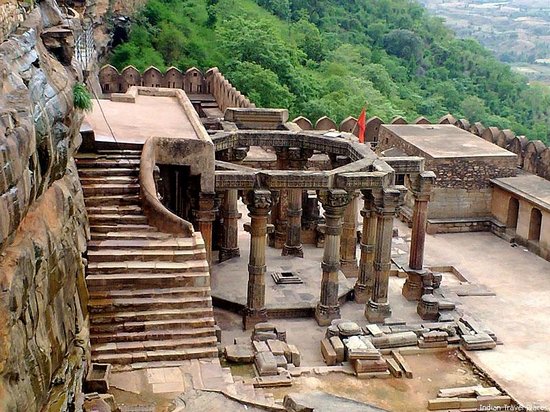
The footpaths are neatly laid out, marked by whitewashed stones. Most of the ancient buildings are in ruins and only three buildings stand in different stages of decay. There is also a museum inside the Palace displaying two millennia of recorded history. The sculptures are mostly of the Chandela era, the treatment by chisel similar to that of Khajuraho temples. After passing through the rows of defensive walls of the Kalinjara Fort, one arrives at the famous Neelkanth temple. The main sanctum of the temple is inside a cave. The rock face on either side of the temple has exquisitely carved panels. Another flight of steps leads you through the third gate, after which you come out into the open, a large undulating hilltop.
Maihar

This little town, which gave Indian classical music the Maihar Gharana, is situated at a distance of 40 km from Satna. Maihar is home to one of the greatest exponents of Hindustani classical music, Ustad Allauddin Khan. The town is also famous for the hilltop temple dedicated to Goddess Sharada.
Fact File
 Area: 38.2 sq. km
Area: 38.2 sq. km
 Population:37,494 (1991 census)
Population:37,494 (1991 census)
 Altitude: 207 m above sea level
Altitude: 207 m above sea level
 Best Time to Visit: July–March
Best Time to Visit: July–March
 Languages:Hindi, Bundeli, and English
Languages:Hindi, Bundeli, and English
 STD Code:0519
STD Code:0519




